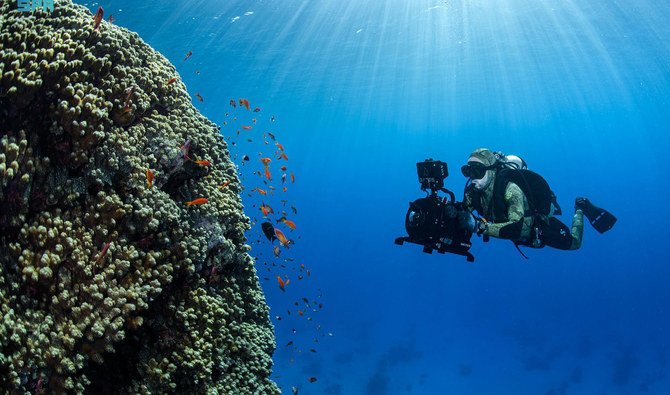
- ARAB NEWS
- 05 Jul 2025

Rawan Radwan
JEDDAH: As long ago as biblical times, humans were fascinated by the waters of the Red Sea. Even now we continue to probe its depths in an attempt to unlock its mysteries and secrets, and learn more about its unique marine environment.
The most recent research project, a six-week expedition in the sea’s northeastern waters, revealed a few mind-boggling surprises.
In October, a crew of 30 boarded the OceanXplorer1, an exploration, research and media vessel described as the most advanced of its kind. The renowned scientists, oceanographers and researchers included experts from the NEOM megacity project, Saudi Ministry of Environment, Water and Agriculture, King Fahd University of Petroleum and Minerals, King Abdullah University of Science and Technology and National Geographic.
They spent in excess of 960 hours mapping more than 1,500 square kilometers of seabed. Not only will their discoveries help to advance knowledge of marine biology, they uncovered new and unexpected information that could change our understanding of the natural world.
Paul Marshall, NEOM’s chief environment officer, is clearly impressed by the pristine waters and largely undisturbed marine life off the coast of the Saudi megacity development. He has worked for more than 30 years on marine environmental projects, including the restoration of coral reefs and innovations in conservation practices.
He told Arab News he realized immediately that there are a lot of undiscovered opportunities in the Red Sea, and “the Kingdom is custodian to an incredible part of the world’s marine environment.”
Working in partnership with ocean exploration initiative OceanX and other researchers, the Red Sea expedition began during a particularly challenging time, in the midst of a global pandemic. But that was just one of the challenges.
For example, the OceanXplorer’s manned deep sea exploration vessels are the most advanced of their kind. They can operate at depths of up to 1,000 meters but in most parts of the world water temperature drops sharply at such depths. In the relatively shallow Red Sea the temperature only drops to about 20 degrees Celsius, which limited the depth at which the submersibles could operate to about 700 meters.
At one spot, they found a big surprise waiting for them. The team believes the remote-operated vehicle spotted a mystery large squid on three occasions at a depth of about 650 meters near a sunken ferry that might be its home.
“We know from its proximity to the ship that we saw a huge squid, around six-to-eight meters long,” said Marshall. “There aren’t many squids that big — but nobody’s ever seen a giant squid in the Red Sea.
“If it is the giant squid, they’ve only ever been filmed underwater twice before. And if it’s not the giant squid, then it’s some other species not known from this area. So we don’t know exactly what it is, but we do know it is hugely exciting.”
The team made many other discoveries, including: a 635-meter high pinnacle (pillar-like elevations that rise from the seafloor); one of the northernmost deep-sea brine pools (pools of water on the seabed with much higher salinity than the surrounding ocean); a new crack caused by shifting tectonic plates; and three shipwrecks.
The team also studied so-called “super corals,” which have intrigued scientists for some time. The term refers to species of coral that appear to be particularly resilient to environmental shifts, such as those caused by climate change.
Ameer Abdulla Eweida, director of the Marine Conservation Program at NEOM, was the expedition’s coordinator and chief scientist. He has worked extensively worldwide in the field of marine and coral reef conservation science, and managing the effects of human activity, including pollution, on these vulnerable habitats.
NEOM’s unique Red Sea habitat includes some of the most heat-tolerant coral in the world.
“One of the holy grails of coral science is to understand the evolutionary, biological and oceanographic factors that give these corals the ability to tolerate heat extremes and make them super corals,” said Eweida.
“NEOM’s Red Sea coral reefs have evolved over thousands of years towards a natural tolerance and resilience to high temperatures, and if managed and protected well — and because of their unique traits — they will have a high chance of surviving the effects of global climate change and the warming of the seas,” said Eweida.